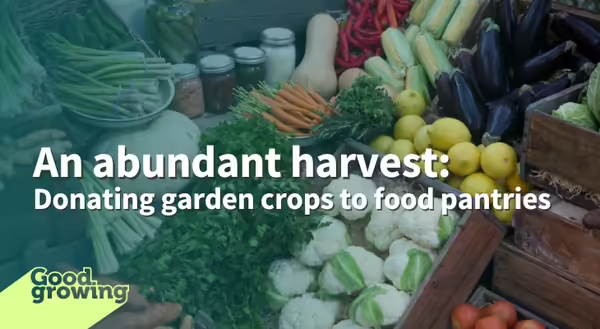
As the summer days pass by, garden harvest becomes a regularly performed task of our Master Gardeners. The demonstration gardens that were so thoughtfully planned, plants or seeds so carefully planted, and growing plants so lovingly tended to for the past few months are producing delicious, nutritious crops. The crops grown by Master Gardeners were always destined to be donated to local food pantries where they will be available to our neighbors in need but home growers can contribute too.
Why donate?
According to the U.S. Department of Agriculture, ten percent of American households experienced food insecurity over the course of a year. Food insecurity is defined as being “uncertain of having or unable to acquire enough food to meet the needs of all their members because they had insufficient money or other resources for food”. By the numbers, in 2021, 33.8 million people lived in households experiencing food insecurity, and 5 million were children within these households.
Community members facing food insecurity can experience life-altering effects beyond the discomfort of physical hunger. The constant worry about obtaining enough food can cause mental health challenges such as depression, anxiety, and post-traumatic stress disorder (PTSD). Children are especially likely to experience negative mental health impacts as a result of food insecurity.
Hunger is distracting and can negatively impact a person’s ability to concentrate. Children are especially susceptible to exhibiting negative behavior due to insufficient food. Empty stomachs result in foul moods, hyperactivity, and aggressive behaviors which can result in negative social outcomes. Additionally, schoolwork can suffer potentially resulting in developmental delays, and learning disabilities because of ongoing hunger.
Finally, food is fuel for the body, and health will suffer when quality food is unavailable. People experiencing ongoing hunger may develop chronic diseases like high blood pressure, heart disease, and diabetes.
Donating extra produce
Many food pantries welcome donations of fresh produce but it is best practice to call prior to harvesting. Contacting the food pantry in advance provides the opportunity to confirm that the facility can properly store and distribute fresh produce. If large quantities of garden produce are being donated, is the need great enough at the location to utilize such a harvest or would it be better to donate to multiple locations?
It is also a good idea to ask which days of the week and times are best for dropping off a donation. Harvesting and delivering produce right before clients pick up groceries is ideal, so foods are at peak freshness.
Neighborhood demographics and cuisine preferences influence produce popularity. Conversations with food pantry managers provide an opportunity to learn about the types of produce their pantry guests prefer. Consider reaching out to your local Illinois Extension SNAP-Ed team to assist with connecting and providing produce to food pantries.
Local food pantries can be found through the Find Food Illinois Community Food Map on the Eat. Move. Save. website. This map allows you to enter your zip code and free food resources in your area will populate. Click the light green food pantries and meal sites icon to view food pantries.
Donating garden produce
The following is a general list of garden produce that is most recognizable to most food pantry clients and is therefore most useful. Most of these crops can be stored for a day or two without refrigeration, which may be a limiting resource at some food pantry locations. Finally, these crops are easy to grow, harvest, and prepare for donation making it easy for the home gardener to share the abundance.
Tomatoes |
Wash gently with water to remove the soil. |
Zucchini |
Wash gently with water to remove the soil. |
Winter squash |
Wash gently with water to remove the soil. |
Potato and sweet potato |
Gently brush off excess soil. Allow potatoes to “cure” for several days before donating.“Cure” potatoes for two weeks at a temperature of 45 to 60 degrees Fahrenheit and 85 to 95 percent humidity. |
Onion |
Gently brush off excess soil. |
Pepper |
Wash gently with water to remove the soil.Refrigerate if donating the following day. |
Cucumber |
Wash gently with water to remove the soil. |
Broccoli |
Wash thoroughly with water to remove the soil.Refrigerate if donating the following day. |
Cabbage |
Wash gently with water to remove the soil.Remove one or two outer leaves, leaving protective leaves in place.Refrigerate if donating the following day. |
Carrot |
Gently brush off excess soil.Cut tops off, leaving one inch of green foliage.Refrigerate if donating the following day. |
Beans |
Wash gently with water to remove the soil.Refrigerate immediately after harvest. |
Garlic |
Gently brush off excess soil.Allow garlic to “cure” for 10-14 days before donating. |
Kale and greens |
Gently brush off excess soil.Refrigerate immediately after harvest. |
Common questions (and answers)
Am I liable for food donations?
-
No, in 1996, President Bill Clinton signed the Bill Emerson Good Samaritan Food Donation Act into law. This standardizes donor ability across all 50 states, the law protects you from liability when you donate to a non-profit and protects you from civil and criminal liability when donating in good faith if the produce later causes harm to the recipient.
Why should I donate only whole produce?
-
Donating whole, uncut food reduces the chance of introducing foodborne pathogens to produce, maintains the maximum shelf-life of food, and makes keeping and distributing the produce easier for pantries.
Sign up for our emails! Want to get notified when new Good Growing posts are available? SIGN ME UP
MEET THE AUTHOR
Emily Swihart is a Horticulture Educator with the University of Illinois Extension, serving Henry, Mercer, Rock Island, and Stark counties since 2021. Emily provides horticulture programming with an emphasis on trees, native vegetation, and home landscape design.